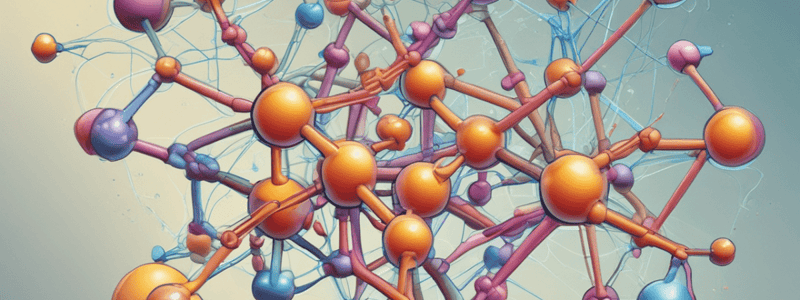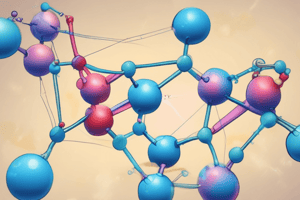Podcast
Questions and Answers
What is the primary difference between aldohexoses and ketohexoses in terms of ring formation?
What is the primary difference between aldohexoses and ketohexoses in terms of ring formation?
- Aldohexoses form open-chain structures, while ketohexoses form ring structures
- Aldohexoses form 5-membered rings, while ketohexoses form 6-membered rings
- Aldohexoses form furanose rings, while ketohexoses form pyranose rings
- Aldohexoses form 6-membered rings, while ketohexoses form 5-membered rings (correct)
What is the name of the type of isomerism exhibited by glucose and galactose?
What is the name of the type of isomerism exhibited by glucose and galactose?
- Diastereomers
- Enantiomers
- Structural isomers
- Epimers (correct)
What is the shape of the 6-membered ring formed by aldohexoses in solution?
What is the shape of the 6-membered ring formed by aldohexoses in solution?
- Planar
- Pyranose ring
- Chair formation (correct)
- Furanose ring
What is the term for molecules that have the same structural formula but differ in spatial configuration?
What is the term for molecules that have the same structural formula but differ in spatial configuration?
How many aldoses and ketoses can be identified in hexose sugars?
How many aldoses and ketoses can be identified in hexose sugars?
What type of reaction occurs between the –OH group and a C=O in hexose sugars to form rings?
What type of reaction occurs between the –OH group and a C=O in hexose sugars to form rings?
What is common to all monosaccharides except dihydroxyacetone?
What is common to all monosaccharides except dihydroxyacetone?
What is the difference between D-glyceraldehyde and L-glyceraldehyde?
What is the difference between D-glyceraldehyde and L-glyceraldehyde?
What is an epimer?
What is an epimer?
What is the term for isomers that differ in their spatial configuration but are not mirror images?
What is the term for isomers that differ in their spatial configuration but are not mirror images?
What is the relationship between D-glucose and D-mannose?
What is the relationship between D-glucose and D-mannose?
What is the term for the carbon atom that becomes asymmetric during cyclisation?
What is the term for the carbon atom that becomes asymmetric during cyclisation?
What is the influence of asymmetric carbons or chirality on compounds?
What is the influence of asymmetric carbons or chirality on compounds?
What is formed when a sugar molecule undergoes cyclisation?
What is formed when a sugar molecule undergoes cyclisation?
What is the classification of carbohydrates based on the number of carbon atoms present in their structures?
What is the classification of carbohydrates based on the number of carbon atoms present in their structures?
What is the difference between aldoses and ketoses?
What is the difference between aldoses and ketoses?
What is the classification of isomers based on their spatial arrangement?
What is the classification of isomers based on their spatial arrangement?
Which of the following is an example of a 4-carbon monosaccharide?
Which of the following is an example of a 4-carbon monosaccharide?
What is the characteristic of monosaccharides?
What is the characteristic of monosaccharides?
What is the difference between erythrose and erythulose?
What is the difference between erythrose and erythulose?
What is the term for isomers that have the same number and kinds of atoms, but differ in their structural or spatial configurations?
What is the term for isomers that have the same number and kinds of atoms, but differ in their structural or spatial configurations?
What is the characteristic of monosaccharides in terms of hydrolysis?
What is the characteristic of monosaccharides in terms of hydrolysis?
What is the characteristic of monosaccharides that makes them unable to be hydrolyzed into simpler forms of carbohydrates?
What is the characteristic of monosaccharides that makes them unable to be hydrolyzed into simpler forms of carbohydrates?
What is the classification of carbohydrates based on the number of carbon atoms present in their structures?
What is the classification of carbohydrates based on the number of carbon atoms present in their structures?
What is the difference between aldoses and ketoses?
What is the difference between aldoses and ketoses?
What is the term for isomers that have the same number and kinds of atoms, but differ in their structural or spatial configurations?
What is the term for isomers that have the same number and kinds of atoms, but differ in their structural or spatial configurations?
What type of ring structure do aldohexoses form in solution?
What type of ring structure do aldohexoses form in solution?
What is the characteristic of monosaccharides in terms of their physical properties?
What is the characteristic of monosaccharides in terms of their physical properties?
How do ketohexoses and aldopentoses differ in ring formation?
How do ketohexoses and aldopentoses differ in ring formation?
What is the term for molecules that have the same structural formula but differ in spatial configuration?
What is the term for molecules that have the same structural formula but differ in spatial configuration?
What is the significance of erythrose and erythulose as examples of 4-carbon monosaccharides?
What is the significance of erythrose and erythulose as examples of 4-carbon monosaccharides?
What is the classification of isomers based on their spatial arrangement?
What is the classification of isomers based on their spatial arrangement?
What is the characteristic of monosaccharides in terms of ring structure?
What is the characteristic of monosaccharides in terms of ring structure?
What is the classification of ribose and ribulose?
What is the classification of ribose and ribulose?
What is the common characteristic of all monosaccharides?
What is the common characteristic of all monosaccharides?
What is the shape of the 6-membered ring formed by aldohexoses in solution?
What is the shape of the 6-membered ring formed by aldohexoses in solution?
What is the primary function of carbohydrates in living organisms?
What is the primary function of carbohydrates in living organisms?
What distinguishing feature sets carbohydrates apart from other biomolecules?
What distinguishing feature sets carbohydrates apart from other biomolecules?
How do monosaccharides, disaccharides, oligosaccharides, and polysaccharides differ in terms of their structural composition?
How do monosaccharides, disaccharides, oligosaccharides, and polysaccharides differ in terms of their structural composition?
What is the significance of carbohydrates in the human body, and why can't we do away with them?
What is the significance of carbohydrates in the human body, and why can't we do away with them?
What are some examples of simple and complex carbohydrates?
What are some examples of simple and complex carbohydrates?
How do aldoses and ketoses differ in terms of their structural composition?
How do aldoses and ketoses differ in terms of their structural composition?
What is the characteristic that defines monosaccharides, and how do they differ from other types of carbohydrates?
What is the characteristic that defines monosaccharides, and how do they differ from other types of carbohydrates?
What is the importance of carbohydrates in maintaining the structure and function of cells and tissues?
What is the importance of carbohydrates in maintaining the structure and function of cells and tissues?
All monosaccharides are aldoses.
All monosaccharides are aldoses.
The classification of carbohydrates is based on the number of carbon atoms present in their structures.
The classification of carbohydrates is based on the number of carbon atoms present in their structures.
Aldoses and ketoses are structural isomers of each other.
Aldoses and ketoses are structural isomers of each other.
Carbohydrates are not essential components of all living organisms.
Carbohydrates are not essential components of all living organisms.
Monosaccharides can be hydrolyzed into simpler forms of carbohydrates.
Monosaccharides can be hydrolyzed into simpler forms of carbohydrates.
Carbohydrates are only found in plants.
Carbohydrates are only found in plants.
Monosaccharides are classified based on the number of carbon atoms present in their structures.
Monosaccharides are classified based on the number of carbon atoms present in their structures.
Aldoses and ketoses have the same structural composition.
Aldoses and ketoses have the same structural composition.
Monosaccharides are soluble in water.
Monosaccharides are soluble in water.
Ketoses are always 6-carbon monosaccharides.
Ketoses are always 6-carbon monosaccharides.
Carbohydrates are not important for the structure and function of cells and tissues.
Carbohydrates are not important for the structure and function of cells and tissues.
Carbohydrates are not essential for human life.
Carbohydrates are not essential for human life.
Glucose is an example of a disaccharide.
Glucose is an example of a disaccharide.
Carbohydrates can be classified as simple and complex carbohydrates.
Carbohydrates can be classified as simple and complex carbohydrates.
Carbohydrates are not essential for the human body and can be eliminated from the diet.
Carbohydrates are not essential for the human body and can be eliminated from the diet.
All carbohydrates have a similar structure.
All carbohydrates have a similar structure.
All monosaccharides contain 1 or more asymmetric carbons.
All monosaccharides contain 1 or more asymmetric carbons.
D-Glucose and D-mannose are epimers at C-2 and C-4.
D-Glucose and D-mannose are epimers at C-2 and C-4.
Anomers are a type of diastereoisomer.
Anomers are a type of diastereoisomer.
The presence of asymmetric carbons influences the optical activity of compounds.
The presence of asymmetric carbons influences the optical activity of compounds.
D-Galactose and D-mannose are epimers.
D-Galactose and D-mannose are epimers.
The C-1 in a ring structure can become the asymmetric centre of the ring.
The C-1 in a ring structure can become the asymmetric centre of the ring.
Epimers are a type of enantiomer.
Epimers are a type of enantiomer.
Stereoisomers have the same structural formula but differ in spatial configuration.
Stereoisomers have the same structural formula but differ in spatial configuration.
Flashcards are hidden until you start studying
Study Notes
Monosaccharides
- Monosaccharides are the basic unit of carbohydrates, water-soluble white crystalline solids with a sweet taste.
- They cannot be hydrolyzed into a simpler form of carbohydrates as they are already in simplest form.
- Examples include glucose, fructose, galactose, ribose (in RNA), and Deoxyribose (in DNA).
Classification of Monosaccharides
- Based on the number of carbon atoms present in their structures:
- Trioses: 3-carbon monosaccharides
- Tetroses: 4-carbon monosaccharides
- Pentoses: 5-carbon monosaccharides (e.g., ribose and ribulose, xylose and xylulose)
- Hexoses: 6-carbon monosaccharides
- Heptoses: 7-carbon monosaccharides
Structural Isomerism
- Aldose and ketose sugars are structural isomers, having the same number and kinds of atoms, but different structural or spatial configurations.
- Examples include erythrose (aldose) and erythulose (ketose), which are 4-carbon monosaccharides.
Ring Structure
- Glucose and fructose do not exist in open-chain structures, but cyclize into rings, forming hemiacetals and hemiketals.
- Hexoses form when the second to last –OH group reacts with a C=O.
- Aldohexoses form 6-membered rings, and ketohexoses and aldopentoses form 5-membered rings.
Haworth Structures
- The 6-membered ring is not planar but rather exists in the chair formation.
- Haworth structures show the ring structure of sugars.
Stereoisomers
- Stereoisomers are molecules with the same structural formula but with different spatial configuration.
- Types of stereoisomers:
- Enantiomers: have four different atoms or groups of atoms attached.
- Epimers: isomers that differ due to the H and OH configuration of carbons 2 or 3 or 4.
- Diastereoisomers: have a different spatial configuration, but are not enantiomers or epimers.
- Anomers: have an additional asymmetric carbon added after cyclization.
Optical Isomerism
- The presence of asymmetric carbons or chirality influences the optical activity of compounds.
- Examples include aldose and ketose sugars, which have different optical activity due to the presence of asymmetric carbons.
Carbohydrates
- Carbohydrates are essential components of all living organisms, including humans, plants, animals, bacteria, and viruses.
- They contain an aldehyde (-CHO) or ketone (-C=O) group with two or more hydroxyl (-OH) groups in their structures.
Monosaccharides
- Monosaccharides are the basic units of carbohydrates.
- They are water-soluble white crystalline solids with a sweet taste.
- Examples include glucose, fructose, galactose, ribose (in RNA), and deoxyribose (in DNA).
- They cannot be hydrolyzed into a simpler form of carbohydrates as they are already in their simplest form.
Classification of Monosaccharides
- Classified based on the number of carbon atoms in their structures:
- Trioses: 3-carbon monosaccharides
- Tetroses: 4-carbon monosaccharides
- Pentoses: 5-carbon monosaccharides
- Hexoses: 6-carbon monosaccharides
- Heptoses: 7-carbon monosaccharides
Isomerism in Monosaccharides
- Ketoses are isomers of aldoses, with the same number and kinds of atoms but different structural or spatial configurations.
- Isomers of carbohydrates can be classified into two classes:
- Structural isomers
- Optical isomers (stereo-isomers)
Structural Isomerism
- Commonly seen differences are on carbons 1 and 2, with no variation in spatial arrangement.
- Examples include erythrose (aldose) and erythulose (ketose), which are 4-carbon monosaccharides.
Ring Structure of Carbohydrates
- In solution, glucose and fructose do not exist in open-chain structures, but rather cyclize into rings, forming hemiacetals and hemiketals.
- Hexoses form when the second to last –OH group reacts with a C=O.
- Aldohexoses form 6-membered rings, and ketohexoses and aldopentoses form 5-membered rings.
Haworth Structures
- Haworth showed that glucose and fructose cyclize into rings, forming hemiacetals and hemiketals.
- The 6-membered ring is not planar, but rather exists in the chair formation.
Stereoisomerism
- Same structural formula but with different spatial configuration.
- Enantiomers – four different atoms or groups of atoms are attached.
Assessment Details
- Practical Assess: Practicals 1 to 8 (10%)
- Make-up Assessment Dates: To be announced
- Practical report Submissions (15%)
- Tutorial Quiz Submissions (5%)
- Main Exam (3 hours): Date to be advised
- Supplementary Exam (3 hours): Date to be advised
Introduction to Carbohydrates
- Carbohydrates are essential components of all living organisms
- Carbohydrates contain an aldehyde (-CHO) or ketone (-C=O) group with two or more hydroxyl (-OH) groups in their structures
- Examples include: Glyceraldehyde, Dihydroxyacetone, Glucose, Fructose
Classification of Carbohydrates
- General classification: monosaccharides, disaccharides, oligosaccharides, polysaccharides, based on the number of monomeric units present
Monosaccharides
- Monosaccharides are the basic unit of carbohydrates
- They are water-soluble white crystalline solids with a sweet taste
- Examples include: glucose, fructose, galactose, ribose (in RNA), Deoxyribose (in DNA)
- They cannot be hydrolyzed into a simpler form of carbohydrates as they are already in simplest form
Classification of Monosaccharides
- Trioses: 3-carbon monosaccharides
- Tetroses: 4-carbon monosaccharides
- Pentoses: 5-carbon monosaccharides
- Hexoses: 6-carbon monosaccharides
- Heptoses: 7-carbon monosaccharides
Isomerism in Monosaccharides
- Ketoses are isomers of aldoses, i.e. same number and kinds of atoms, but different structural or spatial configurations
- Isomers of carbohydrates are classified into two different classes:
- Structural isomers
- Optical isomers or stereo-isomers
Enantiomers: D and L Configurations
- D (dextro) and L (levo) of glyceraldehyde contain a single asymmetric carbon – and are mirror images
- Enantiomers have the same structural formula but with different spatial configuration
Epimers
- Epimers – isomers that differ due to the H and OH configuration of carbons 2 or 3 or 4
- Examples include: D-glucose and D-mannose are epimers at C-2, and D-glucose and D-galactose are epimers at C-4
Diastereoisomers
- D-Glucose and D-mannose are epimers at C-2, and D-glucose and D-galactose are epimers at C-4
- Note: there is no epimeric relationship between D-galactose and D-mannose, their differences are at more than 1 carbon (i.e. 2 and 4); hence they are diastereoisomers – (neither epimers, nor enantiomers)
Anomers
- Anomers - Following cyclisation, there is an additional asymmetric carbon added
- The C-1 in a ring structure can become the asymmetric centre of the ring, resulting in the alpha- and beta-configurations of the sugar
Studying That Suits You
Use AI to generate personalized quizzes and flashcards to suit your learning preferences.




